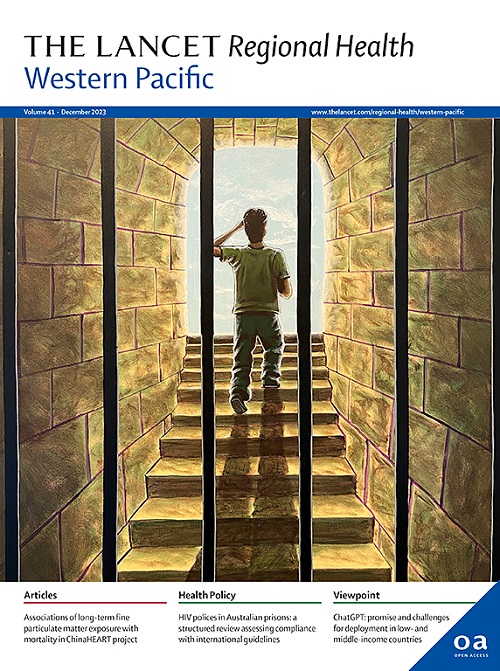Imbalance between muscle strength development and weight gain in children and young adults in China: serial cross-sectional evidence from 1.33 million students from five successive national surveys between 2000 and 2019
IF 8.1
1区 医学
Q1 HEALTH CARE SCIENCES & SERVICES
引用次数: 0
Abstract
Background
Over the past decades, Chinese school-aged children and adolescents have experienced a rapid increase in overweight and obesity, but corresponding changes in muscle strength remain unclear. We aimed to elucidate trends in muscle strength development at both national and subnational level, and to investigate whether it has increased proportionally with weight gain.
Methods
Muscle strength (handgrip strength [kg] for upper body and standing broad jump [cm] for lower body) and weight measurements for 1.33 million children and adolescents aged 7 to 22 were obtained from five waves of the Chinese National Surveys on Students Constitution and Health (2000, 2005, 2010, 2014, and 2019). Trends in muscle strength indicators were investigated using t-test, with post-hoc pairwise comparisons performed using Bonferroni correction. Associations between muscle indicators with weight change were assessed with the Pearson correlation analysis.
Findings
Despite some increase during the first waves of survey, both handgrip strength and standing broad jump declined significantly between 2010 and 2019. The median handgrip strength decreased from 43.9 kg (95% CI 43.7 to 44.1) in 2010 to 42.5 kg (42.3 to 42.8) in 2019 among young males, and from 26.6 kg (26.5 to 26.7) in 2010 and to 26.0 kg (25.8 to 26.1) in 2019 among young females. From 2010 to 2019, median standing broad jump decreased from 234.3 cm (233.8–234.8) to 219.4 cm (218.8–220.1) among males, and from 172.8 cm (172.3–173.3) to 162.5 cm (162.0–163.1) among females. Over the last decade, both measures of muscle strength showed significant declines within each age- and sex-specific quantiles, with the most pronounced decreases observed at the lower quantiles and older ages. The most notable declines were observed in North China, Northeast China, and Middle-West China. As age and weight increased, the initially positive association between body weight and handgrip strength shifted to a progressive weakening, while the association between body weight and standing broad jump changed from non-significant to negative, at −0.51 (95% CI: −0.62 to −0.38) for males and −0.39 (95% CI: −0.52 to −0.24) for females.
Interpretation
This nationally representative study highlights a significant decline in muscle strength among Chinese students over the last decade. The imbalance between increasing body weight and declining muscle strength underscores the urgent need for targeted public health interventions to decrease obesity in Chinese students, to maximize their life-long health expectancy.
Funding
This study was supported by the National Natural Science Foundation of China (82073573 to ZZ; 82204067 to XW; 82273654 to YS).
中国儿童和年轻人肌肉力量发展与体重增加之间的不平衡:来自2000年至2019年连续五次全国调查的133万名学生的连续横断面证据
在过去的几十年里,中国学龄儿童和青少年超重和肥胖的人数迅速增加,但肌肉力量的相应变化尚不清楚。我们的目的是阐明国家和地方层面肌肉力量发展的趋势,并调查它是否随着体重增加而成比例地增加。方法从2000年、2005年、2010年、2014年和2019年五次全国学生体质与健康调查中获取133万名7 ~ 22岁儿童和青少年的肌力(上肢握力[kg],下肢立定跳远[cm])和体重数据。肌力指标的变化趋势采用t检验,事后两两比较采用Bonferroni校正。采用Pearson相关分析评估肌肉指标与体重变化之间的关系。尽管在第一波调查中有所增加,但在2010年至2019年期间,握力和立定跳远都明显下降。年轻男性的中位握力从2010年的43.9 kg (95% CI 43.7至44.1)下降到2019年的42.5 kg(42.3至42.8),年轻女性从2010年的26.6 kg(26.5至26.7)和2019年的26.0 kg(25.8至26.1)。2010 - 2019年,男性立定跳远中位数从234.3 cm(233.8-234.8)下降到219.4 cm(218.8-220.1),女性从172.8 cm(172.3-173.3)下降到162.5 cm(162.0-163.1)。在过去的十年中,肌肉力量的两项测量在每个年龄和性别特定的分位数中都显示出显著的下降,在较低的分位数和较老的年龄中观察到最明显的下降。下降最显著的地区是华北、东北和中西部。随着年龄和体重的增加,体重和握力之间最初的正相关逐渐减弱,而体重和立定跳远之间的相关性从不显著变为负相关,男性为- 0.51 (95% CI: - 0.62至- 0.38),女性为- 0.39 (95% CI: - 0.52至- 0.24)。这项具有全国代表性的研究强调了中国学生在过去十年中肌肉力量的显著下降。体重增加和肌肉力量下降之间的不平衡强调了迫切需要有针对性的公共卫生干预措施来减少中国学生的肥胖,以最大限度地提高他们的终身健康预期。基金资助:国家自然科学基金项目(82073573 to ZZ;82204067到XW;82273654到YS)。
本文章由计算机程序翻译,如有差异,请以英文原文为准。
求助全文
约1分钟内获得全文
求助全文
来源期刊

The Lancet Regional Health: Western Pacific
Medicine-Pediatrics, Perinatology and Child Health
CiteScore
8.80
自引率
2.80%
发文量
305
审稿时长
11 weeks
期刊介绍:
The Lancet Regional Health – Western Pacific, a gold open access journal, is an integral part of The Lancet's global initiative advocating for healthcare quality and access worldwide. It aims to advance clinical practice and health policy in the Western Pacific region, contributing to enhanced health outcomes. The journal publishes high-quality original research shedding light on clinical practice and health policy in the region. It also includes reviews, commentaries, and opinion pieces covering diverse regional health topics, such as infectious diseases, non-communicable diseases, child and adolescent health, maternal and reproductive health, aging health, mental health, the health workforce and systems, and health policy.
 求助内容:
求助内容: 应助结果提醒方式:
应助结果提醒方式:


